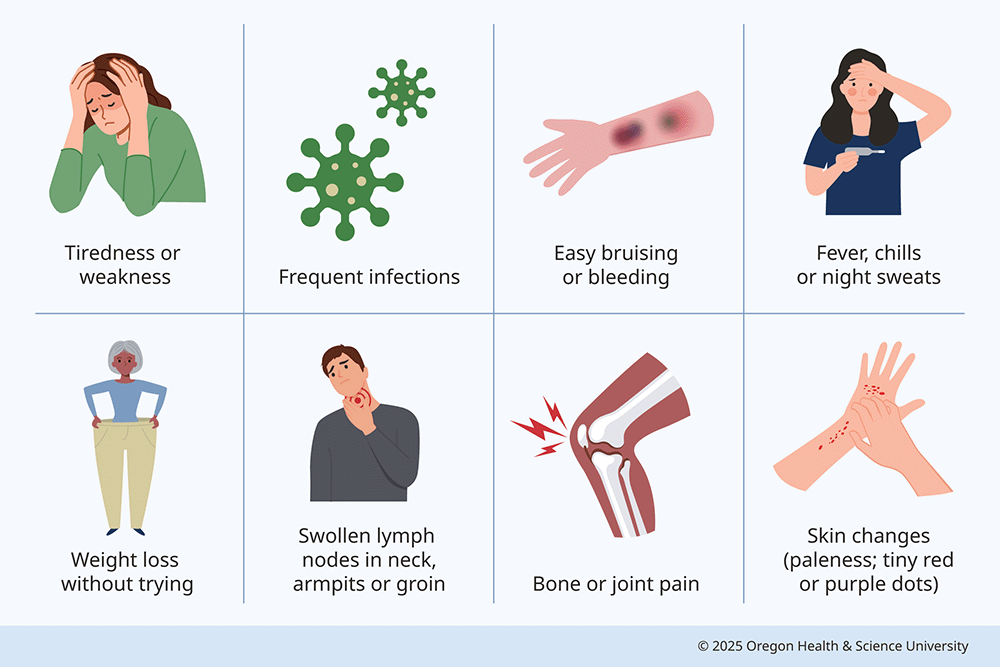Understanding Leukemia
Leukemia is a form of cancer. It generally occurs when the body makes too many blood cells. It’s important to know:
- Leukemia comes in many types.
- Doctors don’t know what causes it, but genetics and environmental factors may play a role.
- Survival rates have improved in recent decades because of groundbreaking advances.
- Advances include Gleevec, a targeted medication developed through research by the Knight Cancer Institute's Brian Druker, M.D.
- Most leukemia patients are older than 55 when diagnosed, but leukemia is also the most common cancer in children.
What is leukemia?
Leukemia is a cancer in which blood cells, usually white blood cells, grow abnormally and don’t work properly. Normally, white blood cells form in bone marrow and travel through the body to fight infection. With leukemia, malformed white cells outnumber the body’s other blood cells:
- Red blood cells that carry oxygen throughout the body (oxygenation)
- Platelets that help blood to clot
This imbalance erodes organ function. It also hurts the ability of red blood cells and platelets to do their jobs. The leukemia cells don’t fight infection as well.
What Happens When You have Leukemia

Who gets leukemia?
Roughly 66,800 new cases of leukemia are diagnosed in the U.S. every year. About 536,000 people in the U.S. live with the condition, according to the National Cancer Institute.
Leukemia’s exact cause is unknown. The disease may have a hereditary component. Risk factors include:
- Gender: Some types of leukemia are more common in men.
- Age: About three in four patients are 55 or older at diagnosis.
- Family history: Having a close relative such as a parent or sibling raises risk.
- Genetic disorders: Down syndrome, neurofibromatosis (marked by tumors in the nervous system) and other genetic disorders come with higher risk.
- Medical history: Previous chemotherapy or radiation therapy can increase risk.
- Chemical exposure: Smoking raises your risk. Exposure to benzene increases risk of acute lymphoblastic leukemia, or AML. Exposure to the herbicide Agent Orange increases risk of chronic lymphocytic leukemia, or CLL.
Survival rates for leukemia
A key concept in understanding survival is five-year relative survival rate. This is the percentage of people who are alive five years after they were first diagnosed, compared to the general population. (It doesn’t count death from other causes.)
The overall survival rate for all types of leukemia has nearly doubled since 1975. Today the five-year relative survival rate for leukemia is 67%. Survival rates are higher for certain types of leukemia and for patients younger than 15.
It’s important to remember that these rates are averages, and can’t predict the outcome for any individual. Also, by definition, these rates reflect the treatments that were available five or more years ago. They don't account for new advances in care.
Leukemia symptoms
Symptoms vary by type. Some of the more common symptoms include:
- Tiredness or weakness
- Frequent infections
- Easy bruising or bleeding
- Fever, chills or night sweats
- Weight loss without trying
- Swollen lymph nodes in the neck, armpits or groin
- Bone or joint pain
- Skin changes, such as paleness, or tiny red or purple dots
Leukemia Signs and Symptoms

Types of leukemia
Doctors classify leukemia by how fast it progresses and by the type of cell it affects:
Progress
- Acute leukemia worsens quickly. It occurs when the abnormal cells are immature blood cells, called blasts, that multiply rapidly.
- Chronic leukemia involves mature blood cells and progresses much more slowly.
Cell type
- Lymphocytic leukemia affects cells that form lymphatic tissue, which is part of the immune system.
- Myeloid leukemia affects myeloid cells, which form the three types of blood cells: red, white and platelets.
Types include:
- Acute lymphoblastic leukemia (ALL), also called acutel lymphocytic leukemia, has no clear cause and can progress rapidly.
- Acute myeloid leukemia (AML) progresses quickly without treatment and can be difficult to treat. It affects cells that aren’t fully developed.
- Chronic lymphocytic leukemia (CLL) is the most common type in adults. Its progression varies.
- Chronic myeloid leukemia (CML) is highly treatable when diagnosed early.
- Hairy cell leukemia (HCL) is a rare type of chronic leukemia with a high survival rate.
- Chronic myelomonocytic leukemia (CMML) is an uncommon blood cancer with an unclear cause.
- Juvenile myelomonocytic leukemia (JMML) is a rare, rapidly progressing cancer that most often affects children six and younger. Learn more about our advanced care for pediatric leukemia at Doernbecher Children’s Hospital.
- Large granular lymphocytic (LGL) leukemia affects white blood cells. There are two kinds, with different rates of progress.
- Blastic plasmacytoid dendritic cell neoplasm (BPDCN) has features of leukemia and lymphoma. Lymphoma is another blood cancer related to an imbalance of infection-fighting cells.
Locations
Knight Cancer Institute, South Waterfront
Center for Health & Healing, Building 2
3485 S. Bond Avenue
Portland, OR 97239
Free parking for patients and visitors
Refer a patient
- Refer your patient to OHSU.
- Call 503-494-4567 to seek provider-to-provider advice.
Cancer clinical trials
Clinical trials allow patients to try a new test or treatment.
Kids and teens

Read more
Learn more about OHSU Knight Cancer Institute treatments: